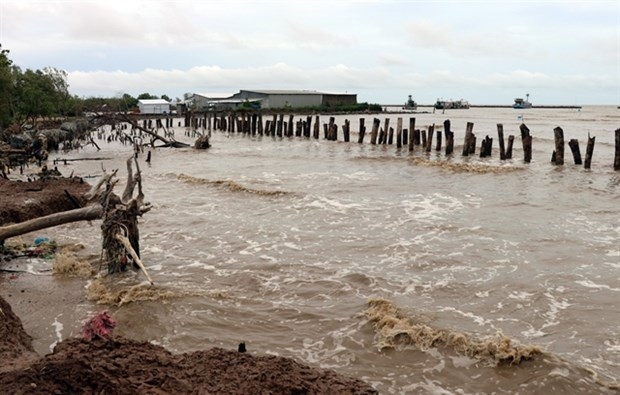Making news
Ancient houses in Quang Tri imbued with typical characteristics of Vietnamese countryside
Ancient houses in Hoi Ky village of Hai Chanh commune, the central province of Quang Tri’s Hai Lang district, still maintains many unique values and characteristics of Vietnamese villages, showing the architectural talent of people in the old times.
Lying beside the O Lau River, Hoi Ky village still preserves century-old houses with unique architecture, which stir up visitors' interest for their unique architectural and cultural values.
The village was established 400 years ago. Locals are always proud of Hoi Ky village, which is protected by bamboo groves and surrounded by the legendary O Lau River.
Hoi Ky village is now home to 16 houses which are over 100 years old, with some built even more than 200 years ago.
The old houses are made of thick solid wood. They usually have three main rooms and two wing rooms, or one main room and two wing rooms.
The roofs of ancient houses in Hoi Ky are covered with yin-and-yang tiles. The columns and doors are engraved with dragons, phoenixes and other delicate patterns.
Depending on the size of the house, each roof has between 10,000 and 20,000 tiles. The tiles are rectangular, thin, flat and can produce a bell sound when knocked on. This way of tiling makes the houses cool in summer and warm in winter. Walls are made from lime and wood hammered bricks. Meanwhile, roofs are low to help the houses withstand strong winds from storms.
The houses’ interior is decorated by their owners, with paintings and lacquered boards. Several families still maintain many old items, making their houses more attractive, nostalgic and rustic.
Altars for Buddha and ancestors, and lacquered boards with parallel sentences teaching people to do good things are usually arranged in the middle room of the houses.
Of the two wing rooms, the one on the left is for males and the one in the right, for females.
The outside space of the ancient houses was also designed in harmony with the nature. Every house is surrounded by trimmed green fences and fruit-laden orchards.
The landscape in the village is beautiful with a river zigzagging around, small lanes, wharves, and a communal yard. These are typical characteristics of the Vietnamese countryside.
Hoi Ky village is also famous for its communal house, temples and ancestral houses of families with unique ancient architecture.
Visiting the village, tourists will have an opportunity to see the tomb of Duong Thi Ngot - the wife of King Thanh Thai (1879 - 1954), and a 300-year-old mango tree - the oldest in the village.
Although it is said to have the most ancient houses in Quang Tri province, the number of the remaining ones in Hoi Ky is quite modest due to the devastation of wars and climate.
Before 1975, the village had more than 100 ancient houses, but because of limited restoration conditions, some are downgrading and others were sold by their owners.
In recent years, locals have tried to preserve remainders. One of the measures being considered is turning ancient houses into tourist destinations.
Bui Van Sinh, Chairman of the Hai Chanh communal People's Committee, said that the communal administration is coordinating with Hai Lang district’s Department of Culture to carry out a project for developing eco-tours to Hoi Ky.
The project is expected to help uphold the unique cultural and architectural values of ancient houses in the village, he said./.
Lying beside the O Lau River, Hoi Ky village still preserves century-old houses with unique architecture, which stir up visitors' interest for their unique architectural and cultural values.
The village was established 400 years ago. Locals are always proud of Hoi Ky village, which is protected by bamboo groves and surrounded by the legendary O Lau River.
Hoi Ky village is now home to 16 houses which are over 100 years old, with some built even more than 200 years ago.
The old houses are made of thick solid wood. They usually have three main rooms and two wing rooms, or one main room and two wing rooms.
The roofs of ancient houses in Hoi Ky are covered with yin-and-yang tiles. The columns and doors are engraved with dragons, phoenixes and other delicate patterns.
Depending on the size of the house, each roof has between 10,000 and 20,000 tiles. The tiles are rectangular, thin, flat and can produce a bell sound when knocked on. This way of tiling makes the houses cool in summer and warm in winter. Walls are made from lime and wood hammered bricks. Meanwhile, roofs are low to help the houses withstand strong winds from storms.
The houses’ interior is decorated by their owners, with paintings and lacquered boards. Several families still maintain many old items, making their houses more attractive, nostalgic and rustic.
Altars for Buddha and ancestors, and lacquered boards with parallel sentences teaching people to do good things are usually arranged in the middle room of the houses.
Of the two wing rooms, the one on the left is for males and the one in the right, for females.
The outside space of the ancient houses was also designed in harmony with the nature. Every house is surrounded by trimmed green fences and fruit-laden orchards.
The landscape in the village is beautiful with a river zigzagging around, small lanes, wharves, and a communal yard. These are typical characteristics of the Vietnamese countryside.
Hoi Ky village is also famous for its communal house, temples and ancestral houses of families with unique ancient architecture.
Visiting the village, tourists will have an opportunity to see the tomb of Duong Thi Ngot - the wife of King Thanh Thai (1879 - 1954), and a 300-year-old mango tree - the oldest in the village.
Although it is said to have the most ancient houses in Quang Tri province, the number of the remaining ones in Hoi Ky is quite modest due to the devastation of wars and climate.
Before 1975, the village had more than 100 ancient houses, but because of limited restoration conditions, some are downgrading and others were sold by their owners.
In recent years, locals have tried to preserve remainders. One of the measures being considered is turning ancient houses into tourist destinations.
Bui Van Sinh, Chairman of the Hai Chanh communal People's Committee, said that the communal administration is coordinating with Hai Lang district’s Department of Culture to carry out a project for developing eco-tours to Hoi Ky.
The project is expected to help uphold the unique cultural and architectural values of ancient houses in the village, he said./.
VNA/VNP

















